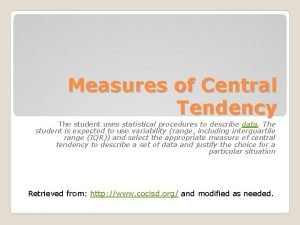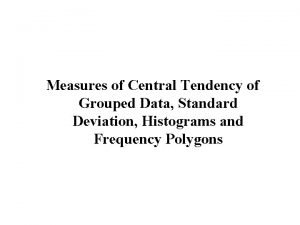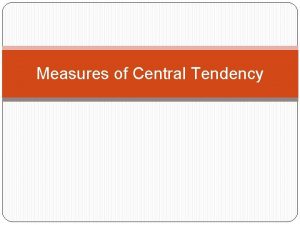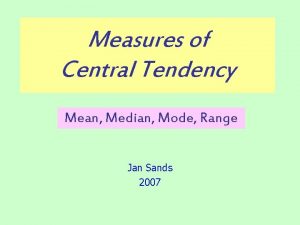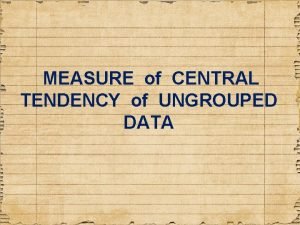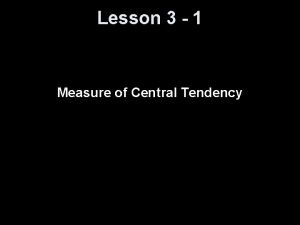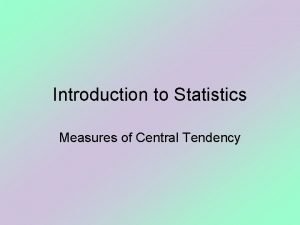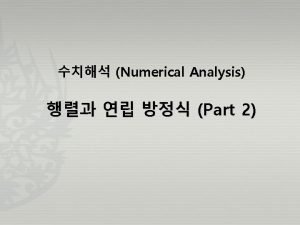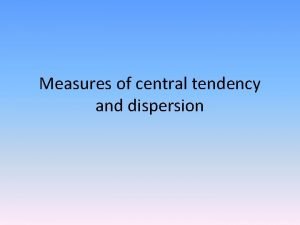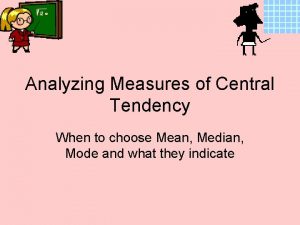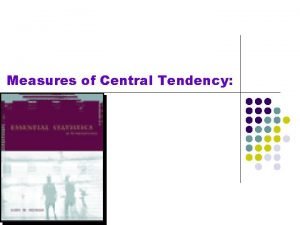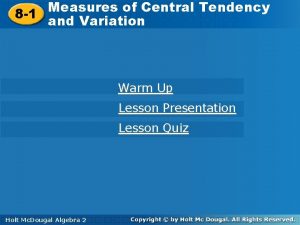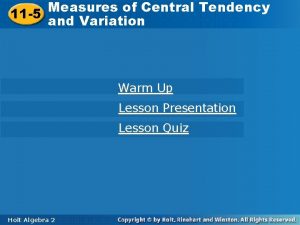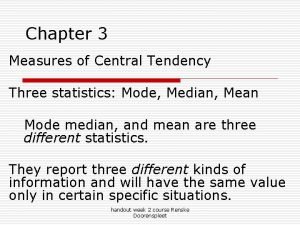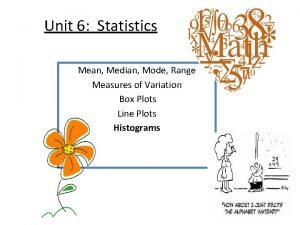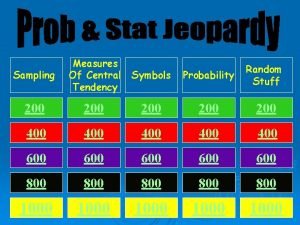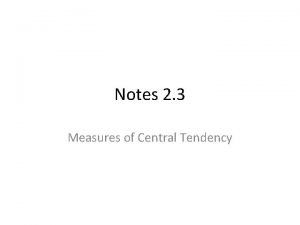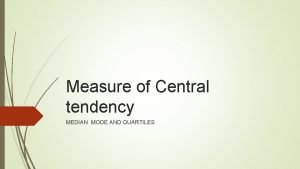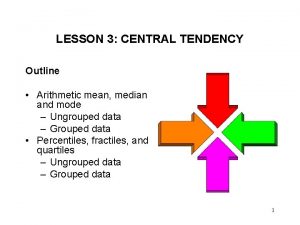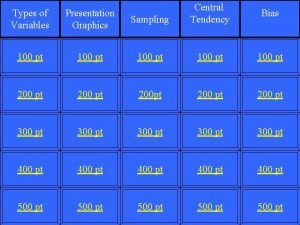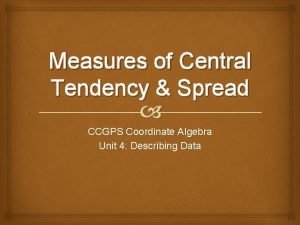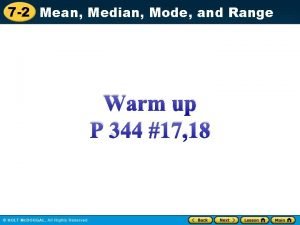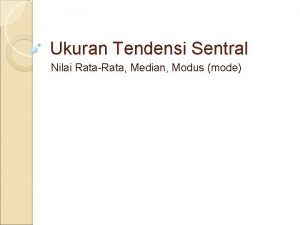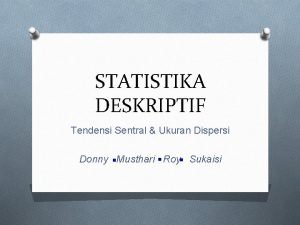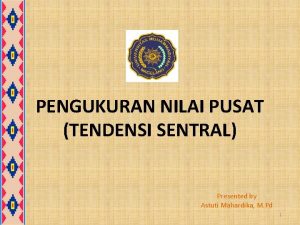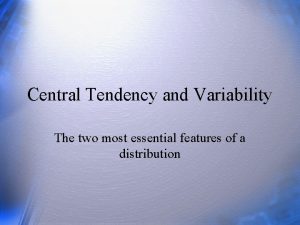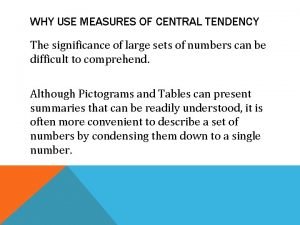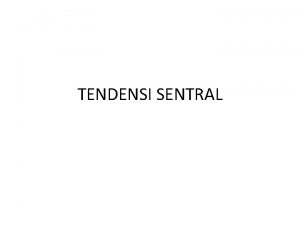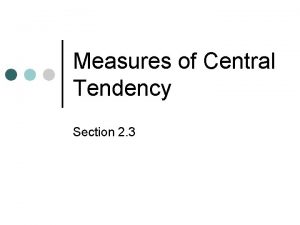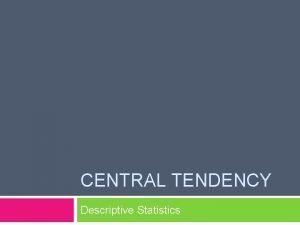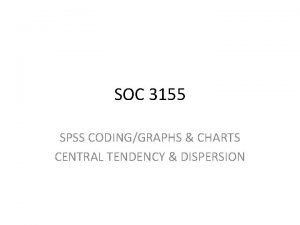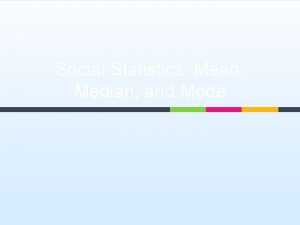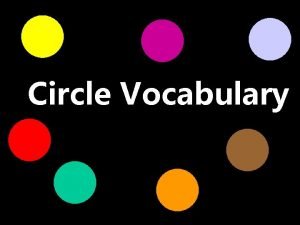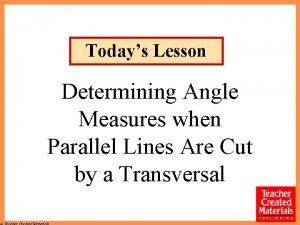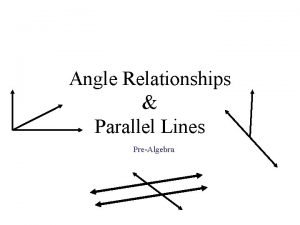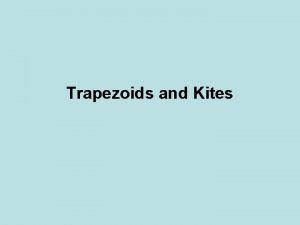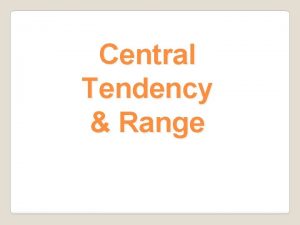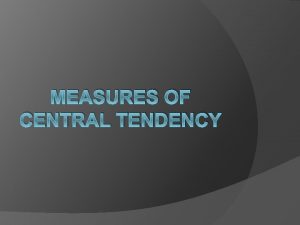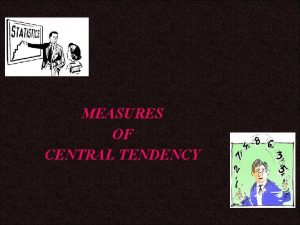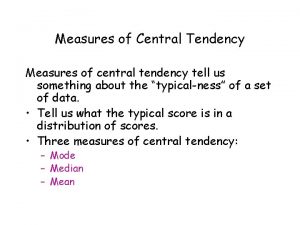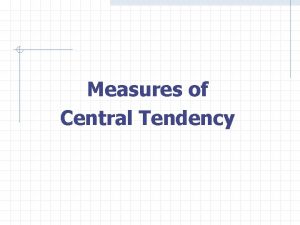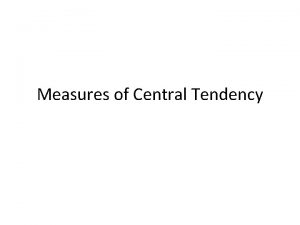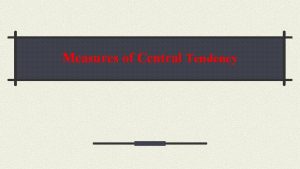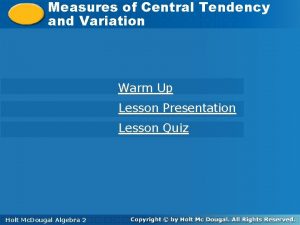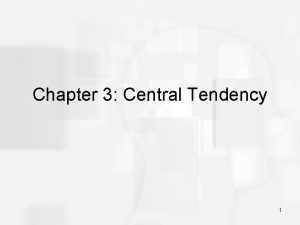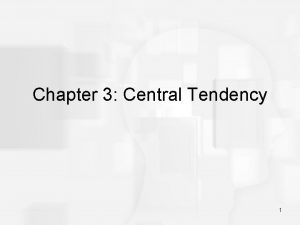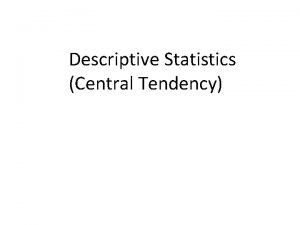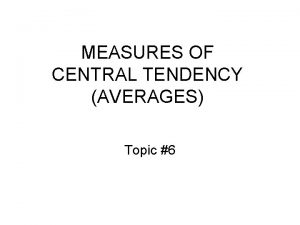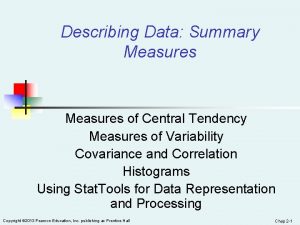7 1 Measures of Central Tendency n Find













































- Slides: 45


7. 1 Measures of Central Tendency n Find the mean n Find the median n Find the mode n Make and interpret a frequency distribution n Find the mean of grouped data Business Math, Eighth Edition Cleaves/Hobbs © 2009 Pearson Education, Inc. Upper Saddle River, NJ 07458 All Rights Reserved

Key Terms n Data set: a collection of values or measurements that have a common characteristic. n Statistic: a standardized, meaningful measure of a set of data that reveals a certain feature or characteristic of the data. Business Math, Eighth Edition Cleaves/Hobbs © 2009 Pearson Education, Inc. Upper Saddle River, NJ 07458 All Rights Reserved

Key Terms n Mean: the arithmetic average of a set of data or sum of the values divided by the number of values. n Median: the middle value of a data set when the values are arranged in order of size. n Mode: the value or values that occur most frequently in a data set. Business Math, Eighth Edition Cleaves/Hobbs © 2009 Pearson Education, Inc. Upper Saddle River, NJ 07458 All Rights Reserved

7. 1. 1 Find the Mean n A business records its daily sales. These values are an example of a data set. Data sets can be used to: ¡ Observe patterns ¡ Interpret information ¡ Make predictions about future activity Business Math, Eighth Edition Cleaves/Hobbs © 2009 Pearson Education, Inc. Upper Saddle River, NJ 07458 All Rights Reserved

Find the mean of a data set 1. Find the sum of the values. 2. Divide the sum by the total number of values. Mean = Business Math, Eighth Edition Cleaves/Hobbs sum of values number of values © 2009 Pearson Education, Inc. Upper Saddle River, NJ 07458 All Rights Reserved

Here’s an example Sales figures for the last week for the Western Region have been as follows: n Monday $4, 200 Tuesday $3, 980 Wednesday $2, 400 Thursday $3, 100 Friday $4, 600 What is the average daily sales figure? n (4, 200 + 3, 980 + 2, 400 + 3, 100 + 4, 600) ÷ 5 = 3, 656 n n n Business Math, Eighth Edition Cleaves/Hobbs © 2009 Pearson Education, Inc. Upper Saddle River, NJ 07458 All Rights Reserved

Try these examples n Mileage for the new salesperson has been 243, 567, 766, 422 and 352 this week. What is the average number of miles traveled? n 470 miles daily n Prices from different suppliers of 500 sheets of copier paper are as follows: $3. 99, $4. 75, $3. 75 and $4. 25. What is the average price? n $4. 19 Business Math, Eighth Edition Cleaves/Hobbs © 2009 Pearson Education, Inc. Upper Saddle River, NJ 07458 All Rights Reserved

7. 1. 2 Find the Median n Arrange the values in the data set from smallest to largest (or largest to smallest) and select the value in the middle. n If the number of values is odd, it will be exactly in the middle. n If the number of values is even, identify the two middle values. Add them together and divide by two. Business Math, Eighth Edition Cleaves/Hobbs © 2009 Pearson Education, Inc. Upper Saddle River, NJ 07458 All Rights Reserved

Here is an example n A recent survey of the used car market for the particular model John was looking for yielded several different prices: $9, 400, $11, 200, $5, 900, $10, 000, $4, 700, $8, 900, $7, 800 and $9, 200. Find the median price. n Arrange from highest to lowest: $11, 200, $10, 000, $9, 400, $9, 200, $8, 900, $7, 800, $5, 900 and $4, 700. n Calculate the average of the two middle values. n (9, 200 + 8, 900) ÷ 2 = $9, 050 or the median price Business Math, Eighth Edition Cleaves/Hobbs © 2009 Pearson Education, Inc. Upper Saddle River, NJ 07458 All Rights Reserved

Try this example n Five local moving companies quoted the following prices to Bob’s Best Company: $4, 900, $3800, $2, 700, $4, 400 and $3, 300. Find the median price. n $3, 800 Business Math, Eighth Edition Cleaves/Hobbs © 2009 Pearson Education, Inc. Upper Saddle River, NJ 07458 All Rights Reserved

7. 1. 3 Find the Mode n Find the mode in a data set by counting the number of times each value occurs. n Identify the value or values that occur most frequently. n There may be more than one mode if the same value occurs the same number of times as another value. n If no one value appears more than once, there is no mode. Business Math, Eighth Edition Cleaves/Hobbs © 2009 Pearson Education, Inc. Upper Saddle River, NJ 07458 All Rights Reserved

Find the mode in this data set n Results of a placement test in mathematics included the following scores: 65, 80, 90, 85, 95, 80, 70 and 80. n Which score occurred the most frequently? n 80 is the mode. It appeared three times. Business Math, Eighth Edition Cleaves/Hobbs © 2009 Pearson Education, Inc. Upper Saddle River, NJ 07458 All Rights Reserved

Use the mean, median and mode n A university recruiter is evaluating the number of community service hours performed by ten students who are applying for a job on campus. n Observe the mean, median and mode from this data set and determine which one or ones might help the recruiter the most in making a realistic assessment of the number of service hours performed last semester. (see next slide) Business Math, Eighth Edition Cleaves/Hobbs © 2009 Pearson Education, Inc. Upper Saddle River, NJ 07458 All Rights Reserved

How many hours? n n n n n Jack: Michelle: Bill: Jackie: Jason: Larissa: Tony: Melanie: Art: Sheila: Business Math, Eighth Edition Cleaves/Hobbs 10 14 5 2 20 12 2 18 1 0 n The mode is 2 n The mean is 8. 4 n The median is 7. 5 n Of the three values, which one or one(s) would help you make a realistic assessment of the number of service hours? n Why? © 2009 Pearson Education, Inc. Upper Saddle River, NJ 07458 All Rights Reserved

7. 1. 4 Make and Interpret a Frequency Distribution n Identify appropriate intervals for the data. Tally the data for the intervals. Count the number in each interval. Business Math, Eighth Edition Cleaves/Hobbs © 2009 Pearson Education, Inc. Upper Saddle River, NJ 07458 All Rights Reserved

Key Terms n Class intervals: special categories for grouping the values in a data set. n Tally: a mark that is used to count data in class intervals. n Class frequency: the number of tallies or values in a class interval. n Grouped frequency distribution: a compilation of class intervals, tallies, and class frequencies of a data set. Business Math, Eighth Edition Cleaves/Hobbs © 2009 Pearson Education, Inc. Upper Saddle River, NJ 07458 All Rights Reserved

Look at this example using the same test scores n Test scores on the last math test were as follows: 78 84 95 88 99 92 87 94 90 77 n Make a relative frequency distribution using intervals of 75 -79, 80 -84, 85 -89, 9094, and 95 -99. (see next slide) Business Math, Eighth Edition Cleaves/Hobbs © 2009 Pearson Education, Inc. Upper Saddle River, NJ 07458 All Rights Reserved

Look at this example Class Interval 75 -79 80 -84 85 -89 90 -94 95 -99 Total 78 84 95 88 99 92 87 94 90 77 Class Relative Frequency Calculations Frequency 2 2/10 20% 1 1/10 10% 2 2/10 20% 3 3/10 30% 2 2/10 20% 10 10/10 100% Business Math, Eighth Edition Cleaves/Hobbs © 2009 Pearson Education, Inc. Upper Saddle River, NJ 07458 All Rights Reserved

7. 1. 5 How to Find the Mean of Grouped Data n n n Make a frequency distribution. Find the products of the midpoint of the interval and the frequency for each interval for all intervals. Find the sum of the frequencies. Find the sum of the products from step 2. Divide the sum of the products by the sum of the frequencies. Business Math, Eighth Edition Cleaves/Hobbs © 2009 Pearson Education, Inc. Upper Saddle River, NJ 07458 All Rights Reserved

Look at this example using the same test scores n Test scores on the last math test were as follows: 78 84 95 88 99 92 87 94 90 77 n Make a relative frequency distribution using intervals of 75 -79, 80 -84, 85 -89, 9094, and 95 -99. (see next slide) Business Math, Eighth Edition Cleaves/Hobbs © 2009 Pearson Education, Inc. Upper Saddle River, NJ 07458 All Rights Reserved

Look at this example 78 84 95 88 99 92 87 94 90 77 Class Interval Frequency 75 -79 2 80 -84 1 85 -89 2 90 -94 3 95 -99 2 Total 10 Midpoint 77 82 87 92 97 Product of Midpoint and Frequency 154 82 174 276 194 880 Mean of the grouped data: 880 ÷ 10 = 88 Business Math, Eighth Edition Cleaves/Hobbs © 2009 Pearson Education, Inc. Upper Saddle River, NJ 07458 All Rights Reserved

7. 2 Graphs and Charts n Interpret and draw a bar graph. n Interpret and draw a line graph. n Interpret and draw a circle graph. Business Math, Eighth Edition Cleaves/Hobbs © 2009 Pearson Education, Inc. Upper Saddle River, NJ 07458 All Rights Reserved

7. 2. 1 Draw and Interpret a Bar Graph n Write an appropriate title. n Make appropriate labels for bars and scale. The intervals should be equally spaced and include the smallest and largest values. n Draw horizontal or vertical bars to represent the data. Bars should be of uniform width. n Make additional notes as appropriate to aid interpretation. Business Math, Eighth Edition Cleaves/Hobbs © 2009 Pearson Education, Inc. Upper Saddle River, NJ 07458 All Rights Reserved

Here’s an example Business Math, Eighth Edition Cleaves/Hobbs © 2009 Pearson Education, Inc. Upper Saddle River, NJ 07458 All Rights Reserved

7. 2. 2 Interpret and Draw a Line Graph n Write an appropriate title. n Make and label appropriate horizontal and vertical scales, each with equally spaced intervals. Often, the horizontal scale represents time. n Use points to locate data on the graph. n Connect data points with line segments or a smooth curve. Business Math, Eighth Edition Cleaves/Hobbs © 2009 Pearson Education, Inc. Upper Saddle River, NJ 07458 All Rights Reserved

Here’s an example Business Math, Eighth Edition Cleaves/Hobbs © 2009 Pearson Education, Inc. Upper Saddle River, NJ 07458 All Rights Reserved

7. 2. 3 Interpret and Draw a Circle Graph n Write an appropriate title. n Find the sum of values in the data set. n Represent each value as a fraction or decimal part of the sum of values. n For each fraction, find the number of degrees in the sector of the circle to be represented by the fraction or decimal. (100% = 360°) n Label each sector of the circle as appropriate. Business Math, Eighth Edition Cleaves/Hobbs © 2009 Pearson Education, Inc. Upper Saddle River, NJ 07458 All Rights Reserved

Here’s an example Business Math, Eighth Edition Cleaves/Hobbs © 2009 Pearson Education, Inc. Upper Saddle River, NJ 07458 All Rights Reserved

7. 3 Measures of Dispersion n Find the range. n Find the standard deviation. From here to there. . . Business Math, Eighth Edition Cleaves/Hobbs © 2009 Pearson Education, Inc. Upper Saddle River, NJ 07458 All Rights Reserved

Key Terms n Measures of central tendency: statistical measurements such as the mean, median or mode that indicate how data groups toward the center. n Measures of variation or dispersion: statistical measurement such as the range and standard deviation that indicate how data is dispersed or spread. Business Math, Eighth Edition Cleaves/Hobbs © 2009 Pearson Education, Inc. Upper Saddle River, NJ 07458 All Rights Reserved

Key Terms n Range: the difference between the highest and lowest values in a data set. (also called the spread) n Deviation from the mean: the difference between a value of a data set and the mean. n Standard variation: a statistical measurement that shows how data is spread above and below the mean. Business Math, Eighth Edition Cleaves/Hobbs © 2009 Pearson Education, Inc. Upper Saddle River, NJ 07458 All Rights Reserved

Key Terms n Variance: a statistical measurement that is the average of the squared deviations of data from the mean. The square root of the variance is the standard deviation. n Square root: the quotient of number which is the product of that number multiplied by itself. The square root of 81 is 9. (9 x 9 = 81) n Normal distribution: a characteristic of many data sets that shows that data graphs into a bell -shaped curve around the mean. Business Math, Eighth Edition Cleaves/Hobbs © 2009 Pearson Education, Inc. Upper Saddle River, NJ 07458 All Rights Reserved

7. 3. 1 Find the Range in a Data Set n Find the highest and lowest values. n Find the difference between the two. n Example: The grades on the last exam were 78, 99, 87, 84, 60, 77, 80, 88, 92, and 94. The highest value is 99. The lowest value is 60. The difference or the range is 39. Business Math, Eighth Edition Cleaves/Hobbs © 2009 Pearson Education, Inc. Upper Saddle River, NJ 07458 All Rights Reserved

7. 3. 2 Find the Standard Deviation n The deviation from the mean of a data value is the difference between the value and the mean. n Get a clearer picture of the data set by examining how much each data point differs or deviates from the mean. Business Math, Eighth Edition Cleaves/Hobbs © 2009 Pearson Education, Inc. Upper Saddle River, NJ 07458 All Rights Reserved

Deviations from the mean n When the value is smaller than the mean, the difference is represented by a negative number indicating it is below or less than the mean. n Conversely, if the value is greater than the mean, the difference is represented by a positive number indicating it is above or greater than the mean. Business Math, Eighth Edition Cleaves/Hobbs © 2009 Pearson Education, Inc. Upper Saddle River, NJ 07458 All Rights Reserved

Find the deviation from the mean n Find the mean of a set of data. n Mean = Sum of data values Number of values n Find the amount that each data value deviates or is different from the mean. n Deviation from the mean = Data value Mean Business Math, Eighth Edition Cleaves/Hobbs © 2009 Pearson Education, Inc. Upper Saddle River, NJ 07458 All Rights Reserved

Here’s an example n Data set: 38, 43, 45, 44 n Mean = 42. 5 n 1 st value: 38 – 42. 5 = -4. 5 below the mean n 2 nd value: 43 – 42. 5 = 0. 5 above the mean n 3 rd value: 45 – 42. 5 = 2. 5 above the mean n 4 th value: 44 – 42. 5 = 1. 5 above the mean Business Math, Eighth Edition Cleaves/Hobbs © 2009 Pearson Education, Inc. Upper Saddle River, NJ 07458 All Rights Reserved

Interpret the information n One value is below the mean and its deviation is -4. 5. n Three values are above the mean and the sum of those deviations is 4. 5. n The sum of all deviations from the mean is zero. This is true of all data sets. n We have not gained any statistical insight or new information by analyzing the sum of the deviations from the mean. Business Math, Eighth Edition Cleaves/Hobbs © 2009 Pearson Education, Inc. Upper Saddle River, NJ 07458 All Rights Reserved

Average deviation n Average deviation = Sum of deviations Number of values Business Math, Eighth Edition Cleaves/Hobbs =0 =0 n © 2009 Pearson Education, Inc. Upper Saddle River, NJ 07458 All Rights Reserved

Find the standard deviation of a set of data n A statistical measure called the standard deviation uses the square of each deviation from the mean. n The square of a negative value is always positive. n The squared deviations are averaged (mean) and the result is called the variance. Business Math, Eighth Edition Cleaves/Hobbs © 2009 Pearson Education, Inc. Upper Saddle River, NJ 07458 All Rights Reserved

Find the standard deviation of a set of data n The square root is taken of the variance so that the result can be interpreted within the context of the problem. n This formula averages the values by dividing by one less than the number of values (n-1). n Several calculations are necessary and are best organized in a table. Business Math, Eighth Edition Cleaves/Hobbs © 2009 Pearson Education, Inc. Upper Saddle River, NJ 07458 All Rights Reserved

Find the standard deviation of a set of data 1. 2. 3. 4. 5. Find the mean. Find the deviation of each value from the mean. Square each deviation. Find the sum of the squared deviations. Divide the sum of the squared deviations by one less than the number of values in the data set. This amount is called the variance. 6. Find the standard deviation by taking the square root of the variance. Business Math, Eighth Edition Cleaves/Hobbs © 2009 Pearson Education, Inc. Upper Saddle River, NJ 07458 All Rights Reserved

Find the standard deviation for the following data set: 18 22 29 27 Deviation Squares of Value Mean from Mean Deviation 18 24 18 – 24 = -6 -6 x -6 = 36 22 24 22 – 24 = -2 -2 x -2 = 4 29 24 29 – 24 = 5 5 x 5 = 25 27 24 27 – 24 = 3 3 x 3= 9 Sum of Squared Deviations 74 Business Math, Eighth Edition Cleaves/Hobbs © 2009 Pearson Education, Inc. Upper Saddle River, NJ 07458 All Rights Reserved

Find the standard deviation of a set of data Variance = sum of squared deviations n– 1 Variance = 74 ÷ 3 = 24. 666667 Standard deviation = square root of the variance Standard deviation = 4. 97 rounded Business Math, Eighth Edition Cleaves/Hobbs © 2009 Pearson Education, Inc. Upper Saddle River, NJ 07458 All Rights Reserved
 Measures of central tendency
Measures of central tendency Grouped data measures of central tendency
Grouped data measures of central tendency Objective of central tendency
Objective of central tendency Measures of central tendency range
Measures of central tendency range Central tendency symbols
Central tendency symbols Objectives of measures of central tendency
Objectives of measures of central tendency Measures of central tendency
Measures of central tendency Mean for grouped data
Mean for grouped data Nxn 역행렬 알고리즘
Nxn 역행렬 알고리즘 Central tendency and dispersion
Central tendency and dispersion Choosing the best measure of central tendency worksheets
Choosing the best measure of central tendency worksheets Measures of central tendency symbols
Measures of central tendency symbols Measure of central tendency of grouped data
Measure of central tendency of grouped data Measures of central tendency and variation
Measures of central tendency and variation Measures of central tendency and variation
Measures of central tendency and variation Statistics chapter 3 measures of central tendency
Statistics chapter 3 measures of central tendency Unit 6 review #2 - measures of central tendency
Unit 6 review #2 - measures of central tendency Central tendency symbols
Central tendency symbols Measures of central tendency notes
Measures of central tendency notes Measures of central tendency median
Measures of central tendency median How to do percentile calculation
How to do percentile calculation Central tendency bias
Central tendency bias Central tendency and spread homework
Central tendency and spread homework Use of central tendency
Use of central tendency Central tendency
Central tendency Mean median mode example problems
Mean median mode example problems Contoh soal ukuran tendensi sentral
Contoh soal ukuran tendensi sentral Is range part of central tendency
Is range part of central tendency Pengukuran tendensi sentral
Pengukuran tendensi sentral Central tendency and variability
Central tendency and variability Importance of central tendency
Importance of central tendency Rumus median
Rumus median Central tendency symbols
Central tendency symbols Central tendency
Central tendency Objective of central tendency
Objective of central tendency Central tendency spss
Central tendency spss Summarion notation
Summarion notation Median even number
Median even number How to get frequency distribution
How to get frequency distribution Central tendency symbols
Central tendency symbols Anova repeated measures
Anova repeated measures How to find an angle
How to find an angle How to name major and minor arcs
How to name major and minor arcs 110/2
110/2 Pre algebra angles
Pre algebra angles Find the measures of the numbered angles in each kite
Find the measures of the numbered angles in each kite
